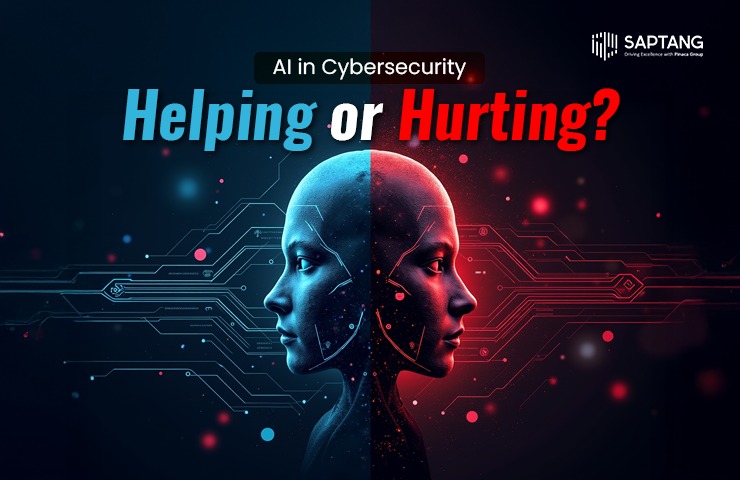
Artificial Intelligence (AI) has quickly become one of the most powerful technologies shaping our world. From healthcare to finance, it’s driving innovation across sectors. But when it comes to AI cybersecurity, the conversation becomes more serious. It’s no longer just about progress; it’s about protection.
For business leaders, security professionals, and government agencies, the real question isn’t if AI will change cybersecurity, and whether it will help us stay ahead of threats or make things more dangerous.
At Saptang Labs, we believe this is one of the most important discussions in today’s digital security landscape. Here’s a closer look at how AI is both strengthening and challenging cybersecurity, and what that means for all of us.
AI has introduced major improvements to the way we detect and respond to cyber threats. The old methods, mostly based on manual processes or simple rules; are no longer enough to deal with modern, fast-moving attacks. AI is helping us in several important ways:
1. Faster Threat Detection and Response
AI systems can scan massive amounts of data in real time and spot unusual behavior faster than any human could. These systems can also take quick action when a known threat appears, often in a matter of seconds.
2. Automated Threat Hunting
By taking over the time-consuming task of sorting through alerts, AI helps security teams focus on what really matters. It also helps find the root cause of incidents more quickly.
3. Predicting Attacks Before They Happen
AI models trained on historical data and current intelligence can recognize early signs of an attack, giving organizations the chance to act before damage is done.
4. Handling Complex Environments
Large businesses often have hundreds of locations, thousands of devices, and multiple cloud platforms. AI gives them the ability to monitor everything in one system, which is key for keeping things secure.
But AI isn’t just being used by defenders; attackers are using it too. We’re now seeing cybercriminals, including state-backed groups, turn to AI to launch faster, smarter, and more targeted attacks.
1. Smarter Phishing Scams
AI can now generate fake emails, text messages, and even voice or video content that looks and sounds very real. These scams are harder to spot and more likely to trick even careful users.
2. AI-Driven Malware
Some malware now uses AI to change its behavior as it moves through a system. This makes it much harder to detect using traditional tools.
3. Tricking AI Systems
Attackers can also target AI tools themselves. By feeding them false or misleading data, they can make the system respond in the wrong way or fail completely.
If AI can help both sides, defenders and attackers; then how should companies use it?
This isn’t just a technical issue. It’s a strategic plan. CEOs, boards, and security teams need to make thoughtful choices about how they build AI into their cybersecurity programs.
At Saptang Labs, we help clients approach this through three key principles:
1. Clear Rules for AI Use
Businesses need to set rules about how AI is built and used including how it makes decisions and what data it’s trained on. It’s important to avoid the “black box” problem, where no one can explain why a system made a decision.
2. Testing and Red Teaming
Just like apps get tested for bugs, AI systems need to be tested for weak points. Can they be fooled? Are they using bad data? These are questions that need clear answers before AI is deployed at scale.
3. AI Plus Human Expertise
AI isn’t here to replace people; it’s here to support them. When AI works side by side with skilled professionals, the results are stronger, faster, and more accurate.
At Saptang Labs, we believe that the best use of AI in cybersecurity comes from balancing automation with responsibility. We work with enterprise and government clients to design security systems that use AI in smart, ethical, and effective ways.
We also monitor how attackers are using AI so we can prepare our clients before new threats emerge. Our strength lies in combining real-time intelligence with AI-powered tools; all tailored to your business needs.
AI in cybersecurity is powerful; but it’s not automatically safe or dangerous. It depends entirely on how it’s used.
Business leaders need to understand both the benefits and the risks. The decisions made today about AI will shape how secure — or vulnerable — their organization is in the future.
At Saptang Labs, we’re here to help you make those decisions with clarity and confidence.
You may also find this valuable : Windows Security Alert: Indian Government Advises Urgent Action for Users